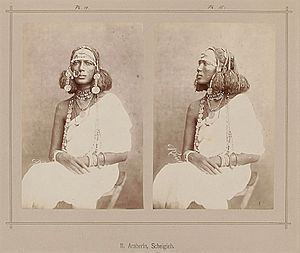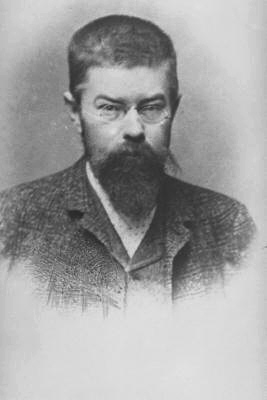Richard Buchta facts for kids
Richard Buchta (born January 19, 1845 – died July 29, 1894) was an Austrian explorer who traveled in East Africa. He was also a writer, painter, and photographer. Buchta was born in Radlow, Galicia, which was part of the Austrian Empire. He traveled a lot, visiting Germany, France, the Balkans, Turkey, Egypt, and the Sudan.
When he returned to Germany and Austria, he wrote several books. These books were about the geography, different ethnic groups, and political situations in the historic Sudan during the 1870s and 1880s. His old photographs, mostly taken in southern Sudan, are thought to be the first pictures of people living along the White Nile River and in areas nearby.
Buchta's Travels and Adventures
In 1877, Richard Buchta arrived in Khartoum, a city in Sudan. Charles George Gordon, who was the Governor-General of the Turkish-Egyptian Sudan at the time, helped him continue his journey. Buchta traveled to Ladó, on the Upper Nile, to meet Emin Pasha.
From there, he explored even further with an Italian explorer named Romolo Gessi. They traveled along the White Nile River, going as far as what is now northern Uganda. Buchta took some of the earliest photos of the people living in these areas. These included groups like the Acholi, Bari, Zande, Shilluk, and Dinka.
When he returned to Germany in 1881, he shared his experiences in a book. The book was called Die obern Nilländer: Volkstypen und Landschaften. This means The Lands of the Upper Nile: Ethnic people and Landscapes in English. It included 160 special photographic prints.
In 1885, Buchta went on another trip. He traveled through Egypt and across the desert to a place called Fayum. He also helped Wilhelm Junker with the first part of his book, Travels in Africa: During the years 1875-1878.
Why Buchta's Photos Are Important

Many of Richard Buchta's photographs have been used for studies about different cultures. They are kept in important collections. For example, you can find them at the Pitt Rivers Museum in Oxford, UK. They are also in the Museum of Ethnology in Vienna, Austria.
Even though other travel writers often used his photos, Buchta's work was mostly forgotten in the 1900s. However, recently, people studying the history of photography in Africa have started to pay more attention to his pictures. They realize how important Buchta's photos were. They also see how his work influenced studies about Africa in the late 1800s.
In 2015, the Pitt Rivers Museum held an exhibition of his photographs. They wrote that Buchta's journey into Equatoria Province (which is now parts of South Sudan and northern Uganda) helped shape how people in Europe saw these regions. His pictures were celebrated and copied, often as engravings, by all the main explorers and writers of central Africa at that time.
Buchta's Books
- Die obern Nilländer, Volkstypen und Landschaften (1881) - This book included 160 photographic views.
- Der Sudan und der Mahdi. Das Land, die Bewohner und der Aufstand (1884) - This book was about Sudan, its people, and a rebellion.
- Der Sudan unter ägyptischer Herrschaft (1888) - This book described Sudan when it was ruled by Egypt.
See also
- Photography in Sudan


